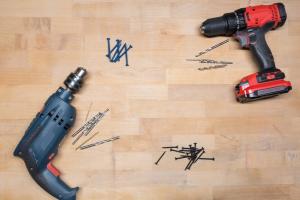Mastering Your Power Drill: A Comprehensive Guide to Swapping Bits Like a Pro

-
Quick Links:
- Introduction
- Understanding Drill Bits
- Tools You Need
- Steps to Swap Bits
- Best Practices for Swapping Bits
- Case Studies
- Expert Insights
- Conclusion
- FAQs
Introduction
Power drills are indispensable tools for any DIY enthusiast or professional contractor. However, one of the key skills that can enhance your experience and efficiency with a power drill is knowing how to swap out the bits. This article will guide you through everything you need to know about changing drill bits effectively, ensuring that you can tackle any project with confidence.
Understanding Drill Bits
Drill bits come in various shapes and sizes, each designed for specific tasks. Here’s a breakdown of the most common types:
- Twist Bits: The most common type for general-purpose drilling in wood and metal.
- Spade Bits: Ideal for drilling large holes in wood.
- Forstner Bits: Used for clean, flat-bottomed holes in wood.
- Masonry Bits: Designed for drilling into concrete and masonry.
- Hole Saws: Used for cutting large holes in various materials.
Tools You Need
Before you start swapping out the bits, ensure you have the following tools on hand:
- Power Drill
- Drill Bits
- Chuck Key (if applicable)
- Safety Goggles
- Work Gloves
Steps to Swap Bits
Swapping bits on your power drill is a straightforward process. Follow these steps for a smooth experience:
Step 1: Safety First
Before handling your drill, make sure it's unplugged or the battery is removed. Wear your safety goggles and gloves to protect yourself from debris.
Step 2: Identify the Chuck Type
Determine whether your drill has a keyed or keyless chuck:
- Keyed Chuck: Requires a chuck key to tighten or loosen.
- Keyless Chuck: Can be tightened or loosened by hand.
Step 3: Remove the Old Bit
For a keyless chuck, grip the chuck and rotate it counterclockwise to loosen. For a keyed chuck, insert the chuck key and turn it counterclockwise to release the bit.
Step 4: Insert the New Bit
Place the new bit into the chuck and tighten securely. Ensure it is straight and aligned properly to avoid wobbling during use.
Step 5: Test the Drill
After securing the new bit, plug in the drill or reinsert the battery. Run the drill briefly to ensure the bit is stable.
Best Practices for Swapping Bits
To enhance your efficiency and ensure safety when swapping bits, consider these best practices:
- Always use the correct bit for the material you’re drilling.
- Keep your bits organized and clean for easy access.
- Regularly inspect your bits for wear and replace as necessary.
- Store bits in a protective case to prevent damage.
Case Studies
Case Study 1: Home Renovation Project
A homeowner embarked on a renovation project and frequently needed to switch between drill bits for different tasks. By mastering the bit-swapping technique, they completed the project ahead of schedule and with better quality finishes.
Case Study 2: Professional Contractor
A professional contractor shared that understanding how to quickly swap bits allowed him to take on more projects in less time, increasing his overall productivity and customer satisfaction.
Expert Insights
According to industry experts, the efficiency of swapping bits can significantly reduce the time spent on projects. It is essential to understand the type of bits you have and their specific applications to maximize your drill's potential.
Conclusion
Swapping out bits on your power drill is a crucial skill that every DIY enthusiast and professional should master. By following the steps outlined in this guide and implementing best practices, you can enhance your productivity and tackle any drilling project with confidence.
FAQs
- Q1: Can I use any drill bit with my power drill?
A1: No, ensure the bit is compatible with your drill type. - Q2: How often should I replace my drill bits?
A2: Replace bits when they show signs of wear or damage. - Q3: What is the difference between a keyed and keyless chuck?
A3: Keyed chucks require a key to tighten, while keyless can be tightened by hand. - Q4: Can I use a drill bit for both wood and metal?
A4: Some bits are versatile but check the specifications for best results. - Q5: How do I know if my bit is tight enough?
A5: The bit should not wobble when the drill is running. - Q6: Are there specialized bits for masonry?
A6: Yes, masonry bits are specifically designed for drilling into concrete. - Q7: What safety precautions should I take when using a power drill?
A7: Always wear safety goggles and gloves, and ensure the drill is unplugged when changing bits. - Q8: Can I use my drill for mixing paint?
A8: Yes, with the appropriate mixing attachment. - Q9: How can I prolong the life of my drill bits?
A9: Store them properly and avoid using them on hard materials unless designed for it. - Q10: Where can I find replacement drill bits?
A10: Hardware stores, tool suppliers, or online marketplaces offer a wide selection.
Random Reads
- How to make faux rocks with concrete diy landscape rocks
- How to use a generator to power your home safely
- How to use a fax machine
- Manage location services iphone ipad
- Manage android home screen icons
- How to test a battery charger
- How to test a thermocouple
- Mastering object unlocking indesign
- How to use a multimeter
- How to use a microphone on pc